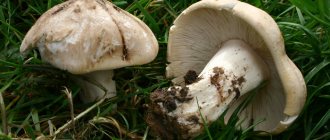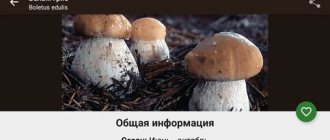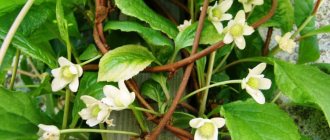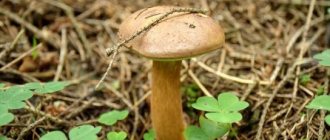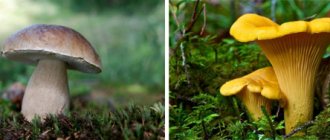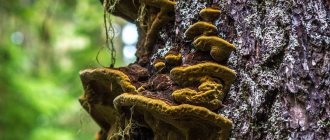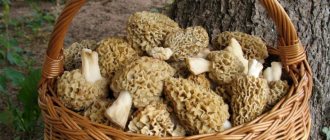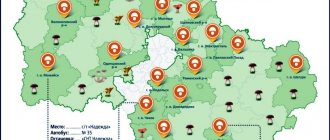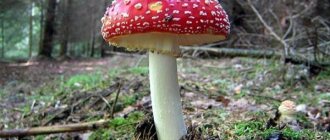Mushrooms
0
2215
Article rating
Kira Stoletova
Often the area rich in forests pleases lovers of “silent hunting” with a good harvest. Mushrooms are not uncommon in the Penza region. Even an inexperienced mushroom picker can find them. Harvest indicators depend on the weather - the presence of rain and heat.
Varieties of mushrooms in the Penza region
Honey mushrooms
Several species of these mushrooms grow in the Penza region. The most common is the autumn honey fungus.
They are usually collected from August to October. Winter mushrooms - from November to spring (during thaws). They often live in mixed forests. They grow on stumps and trees in large groups. You can collect 2-3 buckets in one place.
Honey mushrooms are found in the following settlements of the Gorodishchensky district:
- Chaadaevka;
- Meadow Vyselki.
Not far from the regional center there is the Akhunsky forest, where honey mushrooms are found in large quantities. The forests in the Penza region near the village are also rich in them. Valyaevka, or in the Sosnovoborsky district near the village. Kachim, Inderka and Novaya Lipovka.
Precautionary measures
When going on a “silent hunt”, take a bucket or basket with you. Mushrooms cannot be placed in plastic bags, because... they absorb toxins. Don't collect them near the road. Exhaust gases settle on the mushrooms, and their benefits quickly decrease.
- Author: Maria Sukhorukikh
Rate this article:
- 5
- 4
- 3
- 2
- 1
(0 votes, average: 0 out of 5)
Share with your friends!
Butter
They got their name from their shiny, sticky skin. They grow mainly under coniferous trees, but are also found under birch and oak trees.
They prefer forest edges, clearings, and roadsides. They don't like dark places. They are found from early summer to mid-autumn. These mushrooms do not like the cold; a comfortable temperature is above +15˚С. They stop growing when the soil freezes 2-3 cm.
In the Penza region, boletus is collected in the following places:
- With. Ilmino (Nikolsky district);
- With. Yards (Kuznetsky district);
- With. Kachim, Inderka and Novaya Lipovka (Sosnovoborsky district);
- near the sanatorium “Birch Grove” (Shemyshey district).
Milk mushrooms
They grow up in groups, families. They are classified as conditionally edible mushrooms. Found in mixed and deciduous forests.
The collection season lasts from July to September. They begin to grow after not heavy but prolonged rains. The optimum temperature on the soil is +8…+10°C. Milk mushrooms are popular among mushroom pickers because they have a good taste. They are juicy, flavorful and meaty.
Irina Selyutina (Biologist):
The most popular is the milk mushroom, which enters into a symbiotic relationship with tree species, giving preference to birch and linden, growing in deciduous or mixed forests. It is an active mycorrhiza former. Also important for its development are the age of the trees and the level of soil moisture: the older the forest is, the soil moisture is closer to the average and a sufficient amount of sunlight - you can hope to encounter milk mushrooms. The places where milk mushrooms grow are characterized by a specific “milk mushroom” smell, which is emitted by real milk mushrooms.
Milk mushrooms in the Penza region grow in the following areas:
- near the sanatorium “Birch Grove” in the Shemysheysky district;
- Dubrava in front of the village of Mirny, Mokshansky district.
Inedible species
- Red fly agaric - distinguished by a bright orange or red cap with white flakes on a white ringed stem.
- False honey fungus - has a structure and shape of the fruit similar to the edible mushroom, but a specific color of a bright sulfur-yellow hue.
- The pepper mushroom is a twin of the butter mushroom, distinguished by the absence of a ring on the stalk and the red color of the hymenophore. It has a very strong peppery taste of the pulp, such that it is impossible to hold it in the mouth.
tinygramat
for.the.wild
missmavis66
tessatheowl
Inedible
Saffron milk caps
Mushrooms that grow almost in colonies are found on sandy soil in coniferous forests. Mainly near young pines and larches, but also found in forests. The harvest is harvested from July to October. All types are edible. Saffron milk caps prefer well-lit areas. They grow every year in the same place. Having picked mushrooms once, it’s worth returning to it again next season.
Fans of saffron milk caps should go to the following places:
- With. Russian Mink (Shemysheysky district);
- With. Meadow Vyselki, Chaadaevka (Gorodishchenky district).
Russula
Russulas are found in the forests
There are representatives of edible and inedible species. They grow in July and appear en masse in August and early September.
They live under deciduous trees: oak, birch, alder, as well as under spruce and pine trees. The most common type in the Penza region is white podgrudok (excellent russula).
Irina Selyutina (Biologist):
White Podgruzdok belongs to the Russula genus from the Russula family of the same name. Very often, mushroom pickers call it “dry milk mushroom,” although in fact this species has nothing to do with milk mushrooms and the Milky Way genus. It’s just that in appearance it really does resemble a real milk mushroom, but unlike this species its cap is dry. The cap of the mushroom changes shape and color as it grows: for example, in young specimens it is white, convex, with curled edges, but in older specimens it is concave, covered with spots of yellowish and then ocher color. Also, the color is additionally changed due to sticking leaves, lumps of soil, and twigs.
Russulas also end up in mushroom pickers' baskets. These mushrooms grow in the vicinity of Penza in the following places:
- Shemshgei district – village. Nazimkino, Leninka, Demkino, Naumkino;
- Kamensky district - village. Student.
Mushroom picker of Russia
March 3, 2022
Photo: Anatoly Tarasov
You can also harvest a good harvest of mushrooms at your dacha. It is enough to plant their plantation. And this is not so difficult to do, although you will have to wait a little for the first shoots. What mushrooms are easy to grow in your summer cottage?
The most suitable for “home” cultivation are:
• Oyster mushrooms; • Milk mushrooms; • Boletus; • Boletus mushrooms; • Polish mushrooms; • White mushrooms; • Yellow chanterelles; • Butter; • Chestnut flywheels; • Saffron milk caps; • Russula; • Honey mushrooms and champignons.
But this does not mean that other mushrooms will not grow. You just have to tinker with them longer than with the above types.
Method number 1. Mycelium.
This is one of the easiest ways to transplant mushrooms from the forest to a plot. And first you need to choose a place that is most suitable for growing mushrooms. As a rule, this is the zone of deciduous or coniferous trees, as well as shrubs.
Next, you should step back at least 50 cm from the tree trunk or shrub, dig a ditch no more than 20 cm deep. Its bottom is lined with leaf compost and tree dust. And on top there is a little earth on which a layer containing the mycelium is laid. It is watered and additionally covered with another layer of earth.
If dry and hot days come after planting the mycelium, it needs to be watered periodically. In addition, the place for the mycelium itself should be chosen slightly darkened, because at the beginning of growth a lot of light is not required, but later it will be needed, but also not very much.
Method number 2. Wet hats.
Old overripe mushrooms are taken in a volume of 0.5 kg. Their caps are finely chopped or torn into small pieces, and pour 2 liters. water. 1 tablespoon of flour and 10 grams are immediately added to this mass. gelatin. Everything gets mixed up.
The most important thing is that the mixture is prepared within 10 hours from the moment the mushrooms are collected. Frozen mushrooms are not suitable for this purpose.
The sowing site must be moistened in advance. And on this area (you can also on the garden bed) you should pour the mixed mushroom mass. Expect harvest in 2 seasons.
Method number 3. Dried caps.
You need to collect the overripe mushrooms again. But their caps are cut into large pieces, which are dried for 2 hours. This must be done only in the open air - no fire or other similar source of heat.
Then the soil under the tree chosen for the future mycelium is loosened. This is done 1 meter from the trunk. A layer of leaves is also laid out here. The area is then slightly moistened, and all the pieces are laid out on it with the spores facing down. After 4 days, the caps are removed, and the planting site is watered again, but carefully.
Method number 4. Mycelium from the store.
Fungal spores can be easily purchased at a store that sells seeds. The spore packet should be stored in a cool place.
To find out whether the mycelium is living or not, shake the bag and leave it warm before planting. If everything is in order, the mycelium will begin to grow, and it itself will emit a real mushroom aroma. If the material is unusable, it will emit a sour smell.
How to plant is always written on the package. But let's repeat:
• The place chosen is shaded, moist, but not damp; • A hole is dug at a distance of 0.5 m from the trunk or bush. Its depth is no more than 50 cm. But it all depends on the instructions for the specific type; • The hole is filled with dust, sawdust, leaves to about 20 cm, and on top - a 10 cm layer of earth; • And then - mycelium mixed with soil; • And again everything is covered with earth, watered and covered with old leaves.
The mycelium needs to be looked after: watered and even fed. For this, a sweet infusion is used: 10 liters. water dissolves 10 g. Sahara. With good care, mushrooms will appear within 1 year.
Which tree to plant?
Mushrooms like their neighborhood:
• Any tree will suit honey mushrooms, champignons and oyster mushrooms; • Chanterelles like spruce, birch, beech, oak, and pine trees; • Porcini mushrooms grow well under birch, spruce, oak, and pine; • Red aspen - under aspen, pine - under pine, yellow-brown - under birch, oak - next to oak. But the boletus does not like cherries at all; • Saffron milk caps choose pine and spruce trees; • The boletus prefers birch.
More details: https://www.gorodche.ru/news/society/163098/?utm_source=yxnews&utm_medium=desktop&utm_referrer=https%3A%2F%2Fyandex.ru%2Fnews%2Fsearch%3Ftext%3D
Porcini
Popular among mushroom pickers due to its delicate aroma and piquant taste, as well as the ability to remain white even after prolonged heat treatment. Found in deciduous, coniferous and mixed forests. Loves light, but also appears in shaded places. Porcini mushrooms begin to grow in May–June and end in autumn. They do not like too moist soil and low temperatures.
The porcini mushroom is found in the following localities:
- for s. Zolotarevka, village Valyaevka (Penza district);
- With. Lopatino (Belinsky district)
- With. Meadow Vyselki, Chaadaevka (Gorodishchenky district).
It is also worth going to the Sosnovoborsky district, to the village of Nizhny Katmiss. It’s far away, but there are a lot of porcini mushrooms growing there.
Poisonous mushrooms
A deadly poisonous species grows in this area - the orange-red spider web. Pallid grebe is often found and is the most dangerous. It is constantly confused with green russula.
Other poisonous mushrooms are also found:
- fly agarics;
- false honey mushrooms;
- russula: red, pink, brittle, birch (slightly poisonous, toxic).
Even conditionally edible species can cause poisoning if they are not prepared correctly. Sometimes mycelium (germinated spores) causes allergies.
Measures to avoid poisoning
If there is uncertainty about mushrooms, there are two methods to prevent unpleasant consequences; you need to do the following:
- Wash, boil for half an hour, drain, rinse several more times, it is better if the water is running. Repeat steps two or three times. Toxic substances leave with the decoction.
- Wash, cut, string, hang in a warm, ventilated room, and dry. This cannot be done on radiators or stoves. Toxins evaporate.
These methods do not work on the toadstool.
Interesting Facts
A resident of the Bekovsky district found a truffle - the most expensive mushroom in the world.
Rare species of mushrooms also grow, some of which are listed in the Red Book of the RSFSR. For example, Ggifola umbellata, chestnut mushroom, white aspen, fly agaric.
The main mushroom places in the Penza region are the vicinity of the village. Lopatino, Belinsky district, as well as the village. Meadow Vyselki, Chaadaevka, Gorodishchensky district. All the variety of species is found here. In the Penza region, morels, morels, stitches, pigs, etc. also grow.
Tasty or dangerous
People have been collecting mushrooms since time immemorial. They are dried, boiled, stewed, fried, salted, pickled, frozen. However, the edibility of various mushrooms is still controversial.
“We must remember that mushrooms, being plants by the nature of their main characteristics, contain substances found only in animal products. Thus, the shell of mushrooms contains chitin, but humans do not have an enzyme capable of processing this substance. Therefore, mushrooms are, of course, heavy, difficult to digest food for humans. Extractive substances that give mushrooms a unique taste and aroma cause increased secretion of the gastrointestinal tract, which can lead to exacerbation of existing chronic diseases. This means that the most common mushroom, when consumed, can cause ailments of varying severity,” said the department of Rospotrebnadzor for the Penza region.
